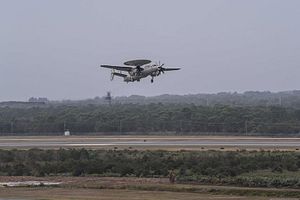U.S. defense contractor Northrop Grumman has announced that it has delivered the first E-2D Advanced Hawkeye (AHE) Airborne Early Warning and Control (AEW&C) aircraft to the Japan Air-Self Defense Force (JASDF), the company said in a May 31 statement.
According to Northrop Grumman, the delivery of the first E-2D already took place on March 29. The aircraft “provides a significant increase in early warning and surveillance capability to outpace Japan’s evolving security needs,” the company notes. Prior to the delivery, the E-2D has undergone flight tests at a test facility in Florida.
“Northrop Grumman’s longstanding partnership with Japan is beginning a new chapter with the delivery of the first Japan E-2D,” said Jane Bishop, vice president of manned airborne surveillance programs at Northrop Grumman. “This aircraft provides a significant increase in early warning and surveillance capability to outpace Japan’s evolving security needs.”
The Japanese Ministry of Defense selected the E-2D in 2014 to enhance the JASDF’s AEW&C capabilities and to supplement the service’s aging fleet of 13 E-2C Hawkeye AEW aircraft, as well as the four Boeing E-767 Airborne Warning and Control System (AWACS) aircraft currently deployed by the JASDF.
In 2015, the MoD placed a $1.7 billion order for four E-2Ds. In October 2018, Japanese Defense Minister, Takeshi Iwaya, announced the procurement of nine additional E-2D for an estimated $3.135 billion. So far, Japan has spent about $1 billion on its E-2D procurement program. A total of five E-2D aircraft are slated to be delivered by the end of 2022.
The E-2D Advanced Hawkeye aircraft has been designed and manufactured by Northrop Grumman. It is a twin-turboprop, carrier-capable tactical airborne early warning aircraft. As I noted in October 2018:
The E-2D is the latest version of the aircraft series equipped with an AN/APY-9 radar, an ultra-high frequency hybrid mechanical/electronically scanned radar system with a 360-degree coverage capability.
The E-2D was designed to help defend aircraft carrier strike groups (CSG) against any type of long-range aerial threats, with each CSG deploying four E-2Cs or E-2Ds. According to Northrop Grumman, the E-2D is capable of detecting a ground-to-air cruise missile launch and stealth aircraft.
Northrop Grumman in its May 31 statement underlines that the E-2D offers “interoperability with next-generation aircraft systems and U.S. Navy allies to support regional security cooperation.”
As I explained in September 2018, the Japanese E-2Ds will have slightly different capabilities than their U.S. counterparts:
Notably unlike U.S. Navy E-2Ds, Japanese E-2D aircraft will not be equipped with the so-called cooperative engagement capability (CEC), a real-time “sensor-netting” system, which allows “the real-time sharing of sensor data on air targets, including incoming enemy aircraft and cruise missiles, among CEC-equipped units,” as I noted elsewhere.
(The Japan Maritime Self Defense Force’s two improved Atago-class guided missile destroyers will reportedly be equipped with CEC, enhancing the ships’ ballistic missile defense capabilities.)
The [JASDF] will also base its aircraft on land allowing it to take off with extra fuel, which will allow the service to operate the aircraft for up to 8 hours, instead of a standard 5 hours (without refueling).
According to the Japanese MoD, the JASDF will station its fleet of 13 E-2Ds at Misawa Air Base in Aomori Prefecture in the northernmost part of Honshu.
































